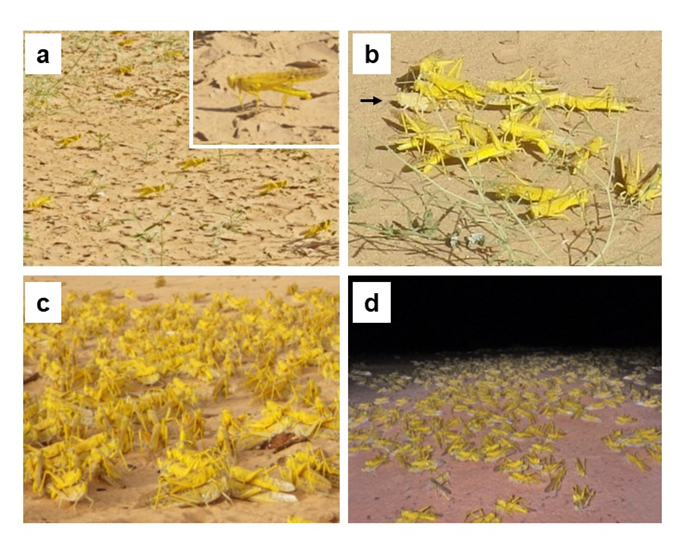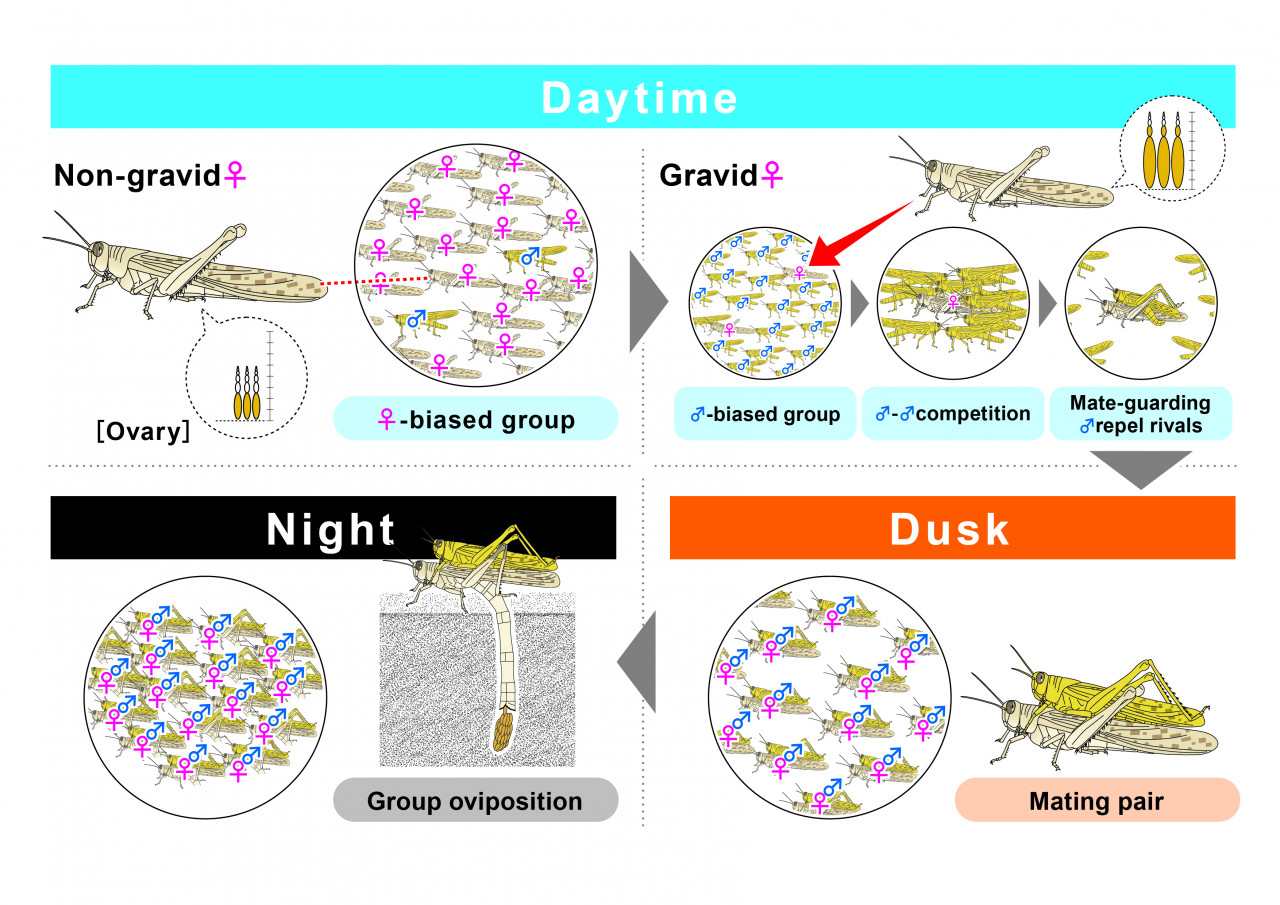研究成果
Elucidation of the Unique Reproductive Behavior of Desert Locust
- Efficient pest control that can lead to reduction in use of pesticides -
Elucidation of the Unique Reproductive Behavior of Desert Locust
- Efficient pest control that can lead to reduction in use of pesticides -
|
Points
|
The Japan International Research Center for Agricultural Sciences (JIRCAS), in collaboration with the Mauritanian National Desert Locust Centre (CNLA), the French Agricultural Research Center for International Development (CIRAD), and the National Centre for Locust Control of Morocco (CNLAA), has clarified previously unknown mating and egg-laying behavior of desert locust in the field.
As a result of field surveys in the Sahara Desert, we found that sexually mature adults of desert locusts formed groups with a biased sex ratio toward males and females. In the female-biased population, most of the female locusts were developing ovaries and did not mate. On the other hand, in the male-biased population, the female locusts had large eggs just before oviposition, and most of them were mating. Detailed investigation revealed that female locusts flew to the male population during the day just before egg laying, mated, and laid eggs in pairs at night. When male and female locusts live together, the male locusts relentlessly press the female locusts to mate, so it is thought that the female locusts avoid male mating harassment by living separately from the male locusts while their ovaries are developing.
It can be inferred that female and male locusts live separately in groups to resolve conflicts and to meet their partners efficiently.
From the perspective of pest control, it is more efficient to wait for the timing of egg-laying at night, instead of immediately controlling the male locust population when it is found during the day. The application of the desert locust ecology is expected to lead to natural and environment-friendly pest control that does not require the use of pesticides more than necessary.
Publication
- Authors
- Maeno, K.O., Piou, C., Ould Ely, S., Ould Mohamed, S., Jaavar, M.E.H., Ghaout, S. and Ould Babah Ebbe, M.A.
- Title
- Density-dependent mating behaviors reduce mating harassment in locusts
- Journal
- Proceedings of the National Academy of Sciences of the United States of America (PNAS),
DOI: https://doi.org/10.1073/pnas.2104673118
For Inquiries
- JIRCAS President
- KOYAMA Osamu
- Program Director
- NAKASHIMA Kazuo
- Researcher-in-charge
- MAENO Kotaro (Crop, Livestock and Environment Division)
- Press Coordinator
- OMORI Keisuke (Head, Information and Public Relations Office)
- koho-jircas@ml.affrc.go.jp
Background and History
Desert locusts are found in semi-arid regions from West Africa to India, and often cause serious agricultural damage. It has been reported that 2020-2021 will see a major outbreak in East Africa and South Asia causing serious agricultural damage. Since desert locusts are found in vast areas and adults in particular fly long distances, it is difficult to control them by spraying pesticides, and in order to mitigate the damage, it is necessary to develop control technologies based on desert locust ecology. To solve this problem, it is important to understand the behavioral patterns of desert locust, especially how adult desert locusts mate and lay eggs in the field during the breeding season. Therefore, we conducted a field survey from 2011 to 2019 with the aim of elucidating the reproductive strategies of desert locust in the Sahara Desert.
Contents and Significance
In this study, we conducted a field survey in the Sahara Desert, which stretches across Mauritania in West Africa, the habitat of desert locust. We simultaneously recorded the sex ratio, mating status, and degree of ovarian development of a population at the transient phase1) to determine how adults in solitarious phase that had become a gregarious phase2) mated.
The results showed that the sex ratio of the population was skewed towards either sex. In the female-biased population, most of the female desert locusts were developing ovaries and were not mating, but most of the females in the male-biased population had large eggs that were about to be laid and were mating. When desert locusts are mating, the male desert locust mounts to the back of the female desert locust, making it impossible for the female desert locust to fly away and more vulnerable to attack by birds and other natural enemies. Male desert locusts are relentless in forcing female desert locusts to mate with them, so females are at a disadvantage when living with male desert locusts. It is thought that female desert locusts during ovarian development avoid unprofitable mating (sexual conflict3)) by living separately from male desert locusts.
A closer look at the male-biased population revealed that during the daytime, when a female desert locust flew into the male population (Fig. 1a) just before oviposition, many males immediately jumped on her and tried to mate, resulting in fierce competition among the male desert locusts (Fig. 1b). When one male desert locust got on the female's back, the other male desert locusts gave up and mated without further competition. After mating, the males remained on the female's back and continued their post-copulatory mate guarding4). In the evening, they gathered in the open sand near where they met (Fig. 1c), and we also found that they oviposited in pairs at night (Fig. 1d). The females are guarded by the males during oviposition, which suggests that they are oviposition in safety. In a group of male desert locusts, competition for females among males is higher, but because they can meet female desert locusts just before oviposition, the time spent guarding them after mating is shorter, and they have more opportunities to mate with other female desert locusts. It can be inferred that the male and female desert locusts are able to meet their partners efficiently while resolving sexual conflicts by living separately in groups.
Pairs that are oviposition in groups remain in place for several hours, making them good targets for pest control. If a group of male desert locusts is found, it is possible to reduce the amount of pesticides used by waiting for the group to oviposit until nighttime instead of immediately controlling them.
Future Plans and Expectations
In the future, we will need to study populations that have been gregarious for several generations, as well as populations in other seasons and regions. We plan to find out how male desert locusts decide where to congregate, and what clues female desert locusts use to visit male groups when they are about to oviposit. We also need to investigate the breeding behavior of another species of desert locust that is causing agricultural damage in many parts of the world, including China and South America. As recommended by the Food and Agriculture Organization of the United Nations, it is hoped that identifying times when desert locust are inactive and intensively spraying pesticides will lead to environmentally and health-conscious pest control that does not use more pesticides than necessary.
Explanation of Terms
- 1) Transient phase
The crowding of adult desert locusts in solitarious phase into gregarious phase occurs, and individuals whose external morphology is solitary but whose behavior is gregarious are in to so-called “transient phase”. The desert locust population investigated in this study is in “transient phase”. When swarming grasshoppers reach sexual maturity, the females turn slightly yellow, but the males turn bright yellow and are very conspicuous.
- 2) Gregarious phase
Desert locusts exhibit “phase polyphenism” in which they change their behavior, morphology, and physiological characteristics in response to crowding. Individuals grown under low density during tranquil conditions are called “solitarious phase”, while those under high density during outbreaks are called “gregarious phase”. The phase changes flexibly in response to crowding, and the transformation of the solitarious phase into the gregarious phase is called “phase polyphenism”
- 3) Sexual conflict
An antagonistic relationship that occurs when males and females have different interests in reproduction.
- 4) Post-copulatory mate guarding
A behavior in which a male protects a mated female from being stolen by another male until she lays eggs. It is known that female desert locusts store the sperm of mated males in their bodies and receive enough sperm for lifelong fertilization in a single mating. In addition, since the sperm of the last male mated is used for fertilization, males have the habit of guarding females until they lay eggs in order to establish paternity.
Fig. 1. Reproductive behavior of the desert locust in the field.
(b) Male desert locusts swarming and fighting for mating with female desert locusts (→) that fly into the male group.
(c) In the evening, pairs gather at a oviposition site.
(d) Pairs laying eggs in a group at night.
Reference diagram. Flow of reproductive behavior
During the day, female desert locusts with developing ovaries stay in groups with a skewed sex ratio toward females and do not mate. When a female desert locust with large eggs just before oviposition flies into a group of male desert locusts, many male desert locusts compete to mate. When one male desert locust rides on the back of the female desert locust, the other male desert locusts give up, no further fighting occurs and then they mate. In the evening, they move in pairs to sandy areas suitable for oviposition and begin to congregate. At night, they oviposit in groups.






